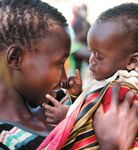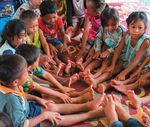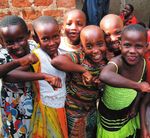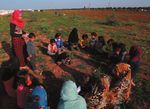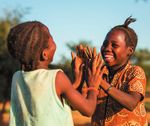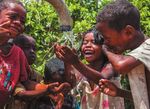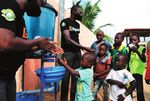Accelerating Results for Children with Technology and Digital Innovation - DIGITAL UNICEF
←
→
Page content transcription
If your browser does not render page correctly, please read the page content below
DIGITAL UNICEF Accelerating Results for Children with Technology and Digital Innovation UNICEF Technology for Development Report INFORMATION COMMUNICATION AND TECHNOLOGY DIVISION
Cover image: © UNICEF/UNI337412/ Indonesia /Dinda Veska Ngaisatul Hikmah (7) - Ais has been living in Muslimin Orphanage in Jakarta since 2016. Ais’ mother passed away, and she hasn’t met her dad for a few years. Usually for her daily routine, Ais goes to school and participates in activities inside and outside of the orphanage. But during COVID-19 pandemic, the orphanage requires the children to stay inside. During the pandemic, donations to the orphanage have been decreasing. This is causing children like Ais to become even more vulnerable.
Foreword
Over the last few years, there has been increasing recognition of the critical role of digital innovation and
technology for development to UNICEF programming and accelerating support to the Sustainable Development
Goals. With the global emergence of the coronavirus pandemic in early 2020, digital development has become
an integral component of UNICEF’s work as national programmes shifted to distance and remote means of
delivery.
With the recent move to transform the Information and Communication Technology Division (ICTD) to an
external facing and field-focused digital programming support function, UNICEF is well positioned to navigate
this new digital programme environment, and has taken a powerful step towards creating an organizational
culture in support of digital innovation and Technology for Development (T4D) that informs every aspect of our
work for children.
The new T4D function, established in 2017, plays a pivotal role in this new digital programming environment.
And in just three years, that role has been recognized as a critical enabler of digital innovation in UNICEF.
According to the 2019 Evaluation of Innovation in UNICEF, this new approach is widely recognized and
appreciated across the organization.
Technology for Development (T4D) staff are not only bringing technologies and digital innovations to the table;
we work with national counterparts and programme and planning staff to think strategically and inter-sectorally
about how the needs of children can be met, and gaps breached, through the use of technology as an enabler.
We do not seek to disrupt, but rather, to build on and align with existing national systems, and to strengthen
national capacities to deliver programmes more effectively and efficiently with the support of technology.
Central to our work are our partnerships within and outside of UNICEF that help enable new ways of
programming so that national counterparts are able to make progress on national goals and priorities with the
support of digital solutions.
This report and the achievements described within are a testament to that commitment to our wide-ranging
partnerships. The examples of our work that you will read about in the following pages underscore the power of
the collaborative approach that UNICEF – through technology for development – has taken to enable and deliver
life-saving services and advance the rights of children.
Daniel Couture
UNICEF Chief Information Officer
3Content
Part 1: Executive Summary..............................5 Humanitarian action.................................49
U-Report.....................................................51
Part 2: About Technology for Development…7
Innovation and frontier technology.........55
Who we are.................................................8 Digital innovation and T4D capacity
development..............................................58
What we do.................................................8
Part 4: Partnerships....................................... 60
INVENT, the T4D and Inventory Platform...9
What are Digital Public Goods?................10 Part 5: Priorities and the way forward..........64
Strengthening national systems
Further information........................................66
using real-time technology.......................12
Part 3: Achievements 2018–2019....................14
Goal Area 1: Every child survives
and Thrives................................................15
Goal Area 2: Every child learns...............28
Goal Area 3: Every child is protected
from violence and exploitation................36
Goal Area 4: Every child lives in a safe
and clean environment.............................41
Goal Area 5: Every child has an equitable
chance in life..............................................45© UNICEF/UNI280369/Burkina Faso/Tremeau/2019
Part 1: Executive Summary
Technology for development and digital innovation – and the practice of exploring new ways of delivering programmes
with new partners and technologies – is increasingly recognized as crucial to meeting the Sustainable Development Goals
(SDGs) and the promise of the 2030 Agenda for Sustainable Development.
At UNICEF, the Technology for Development (T4D) function within the Information and Communication Technology
Division (ICTD) provides advisory, implementation and quality assurance services to programmes on technology and
digital innovation in UNICEF, and leadership on digital innovation. It helps to identify the most promising technologies
and digital innovations for application in different contexts, supporting UNICEF programmes to adopt, adapt and scale
up the approaches that are most useful, and to quickly identify those that are not. It also helps to institutionalize those
technologies and digital innovations that show promise and are ready to be mainstreamed, in close collaboration with
national partners, and in support of national goals and sectoral priorities, the UNICEF Strategic Plan 2018–2021 and the
SDGs.
5In the first three years of the Strategic Plan, ICTD has T4D-supported approaches to programme delivery have
had a powerful impact on scaling digital innovation and also been a critical enabler of UNICEF’s global response
accelerating results for children across the organization. to the worldwide coronavirus (COVID-19) pandemic and
To date, more than 1,400 T4D and innovation initiatives efforts to mitigate the effects of the virus on the health
have been catalogued through INVENT – the global and well-being of children, as well as recovery efforts.
Technology for Development and Innovations Inventory – This report, drafted during the course of 2020, highlights
which provides a view of the universe of T4D initiatives by a number of country COVID-19 response initiatives
Strategic Plan Goal Area, Stage and Scale. These initiatives employing digital innovation and T4D approaches.
span UNICEF programmes across the world and address
children’s health, nutrition, education, protection, access to With ICTD’s support, UNICEF is also exploring how frontier
water, sanitation and hygiene, and inclusion. technologies can aid in both its humanitarian action and
development programmes. For example, the organization
In health, nutrition and early childhood development, has identified drone technology and drone-based
UNICEF has harnessed the power of ICT to support services as a way to improve its work in global health
countries to ensure that every child survives and thrives. and community resilience. In December 2018, UNICEF
That means bringing together a multi-sectoral team to use facilitated one of the first commercial vaccine deliveries by
technology, digital innovation and human-centred design drone in a remote island of Vanuatu. The vaccine delivery
to strengthen health systems and the health system covered almost 40 kilometres of rugged mountainous
enabling environment. For example, in Pakistan, UNICEF terrain from Dillon’s Bay on the west side of the island
has supported the government to use real-time monitoring to the east landing in remote Cook’s Bay, where hard-to-
to strengthen immunization services. The use of the open- reach children and pregnant women were vaccinated by a
source technology, RapidPro, enabled service delivery that registered nurse.
helped providers vaccinate more than 37 million children
against measles in 2018, according to government reports. The achievements for children described above and
throughout this report were made possible by the
UNICEF also recognizes the acute need for innovation thousands of people across UNICEF and its partner
using real-time monitoring. Hard-to-reach rural organizations who have contributed to and supported the
communities are now able to report changes in WASH application of T4D. Looking ahead, UNICEF will continue
infrastructure functionality via SMS directly to government to invest in digital innovation and digital public goods such
extension workers, improving the time it takes to make as those described here and enhance the organization’s
corrective improvements and deliver life-saving services. digital capabilities. That means continuing to standardize
and scale the tools that will position T4D as a trusted
The employment of ICTs is also integral to UNICEF’s programme partner; establish and expand partnerships
effort to provide every child with an equitable chance in with both the public and private sector; and build capacities
life. In Yemen, that includes supporting the unconditional for digital programming across the organization and the
emergency cash transfer project, which is serving about national partners we support.
one third of the country’s population. Given the complexity
of the operation, UNICEF is using Yumnn, an information
management system built to contain and secure the data
of the project’s 9 million beneficiaries. Since adopting
Yumnn, UNICEF Yemen has integrated several technology
solutions – from real-time monitoring tools to a mobile
application for grievance collection in offline areas – to
enhance Yumnn’s capacities for reporting, management
and risk mitigation.
In emergencies, UNICEF is using technology to enhance
UNICEF’s humanitarian action. When Mozambique was
struck by two Level 4 cyclones in less than eight weeks
in 2019, UNICEF worked with government partners to
develop an information system designed to create data
visualization and support real-time decision making. Less
than 72 hours after the second cyclone made landfall,
the government was able to use the system to release
preliminary impact data and initial resettlement camps
were mapped with up-to-date information about the
number of displaced people.
6v
© UNICEF/UN021997/China/Yong Xia
Part 2:
About Technology for Development
The world is changing faster than ever before, and so too are the challenges facing its most vulnerable people. As conflict
and displacement, disasters and climate change, urbanization and disease outbreaks grow increasingly complex and
interrelated, new strategies and approaches to humanitarian response and development assistance are greatly needed.
Technology for development (T4D) and digital innovation – exploring new ways of delivering programmes with new
partners and technologies with the support of information and communication technology (ICT) – is increasingly recognized
as crucial to meeting the Sustainable Development Goals (SDGs) and the promise of the 2030 Agenda for Sustainable
Development. This is the context in which UNICEF’s Information Communication and Technology Division’s T4D teams work
with partners within and beyond UNICEF to achieve results for children.
7Who We Are
Technology is generating important opportunities to Within the Innovation for Results cone, the T4D function is
advance results for children. The T4D function within ICTD embedded within ICTD alongside the Office of Innovation,
provides advisory, implementation and quality assurance the Supply Division, the Office of Global Insight and Policy
services to programmes on technology in UNICEF, and and the Office of Research. The T4D function works in
leadership on digital innovation. close collaboration with national partners, and in support of
national goals and sectoral priorities, the UNICEF Strategic
As part of the global evaluation of innovation in UNICEF, Plan 2018–2021 and the SDGs.
in 2019, ICTD was recognized for its guiding role in
enabling digital innovation. The evaluation recommended ICTD recognizes that innovative digital solutions are useful
that leadership for digital innovation be housed within only when they add value, accelerate service delivery, and
ICTD, while bringing together the various parts of expand reach and results for children; and scale is reached
UNICEF headquarters that are currently working on digital when the digital innovation, programming approach or
innovation. solution is owned and led by a national government.
Box 1: Unpacking how T4D works
We take scalable innovations and technology solutions and deliver them, directly impacting the lives of millions
of children around the globe, each year.
We enable technology and digital innovation in the field at scale, through our strong collaboration with
programme teams, in-country technical advice and support to national partners, and engagement with United
Nations agencies and other partners on technology and digital public goods. We serve as a unique resource,
facilitator and a connector across programmes, planning and operations.
We help identify the most promising technologies and digital innovations for application across the globe, and
support UNICEF programmes to adopt, adapt and scale up the approaches that are most useful, and to quickly
identify those that are not.
We institutionalize and mainstream technologies and digital innovations that show promise, in support of
national goals and priorities, UNICEF’s Strategic Plan and the SDGs.
We support country deployment and testing of frontier technologies to make sure that solutions are designed
and implemented with the best chance for scale and national ownership.
We help country offices develop and promote innovation and T4D strategies that align with the national
governments’ long-term development needs through dedicated strategic planning.
And we continuously build UNICEF and programme partners’ capacities for T4D and innovation governance.
What We Do
ICTD believes that technology, digital innovation and digital The role of T4D is not to innovate on behalf of the
programming are not the mandates of an individual or organization, but to serve as a resource, facilitator and
unit, but the collective responsibility of everyone. Realizing connector. That means building T4D and digital innovation
this vision requires a change in culture and incentives to capacity among UNICEF staff and national partners; and
promote innovative behaviours across the organization, we supporting the development of guidance for country
are reimagining ICT – from a back office support function implementation of T4D and programmes that support
to a digital programming and transformation function – digital innovation, based on evidence, good practices and
and leveraging digital approaches to support programme experience.
effectiveness and accelerate results for children.
8ICTD supports the coordination of T4D and digital digital public goods. That includes supporting knowledge
innovation work across country and regional offices management, learning and the exchange of experiences;
to enhance efficiencies, effectiveness, alignment, and enabling South-South and North-South dialogue,
coherence and governance. That means working in close research and reports on challenges and best practices.
collaboration with UNICEF programme and planning In everything we do, partnerships are essential. ICT staff
functions – including through technical expertise, advisory identify and support partnerships with the public, private
services and policy guidance – to design and support and academic sectors to drive UNICEF programming
evidence-based T4D and digital initiatives. enabled by T4D and digital innovation. We also work to
leverage the comparative advantage, experience and
In countries, T4D staff work with programme and planning resources of other United Nations agencies, donors and
teams across UNICEF to strengthen national systems partners through joint planning, coordination, programming
and deploy new digital approaches to programming. and experience sharing of T4D and digital initiatives to
We contribute to scaling up well-established and proven achieve results for children.
products and innovative approaches and tools, including
INVENT, the T4D and innovation Inventory Platform
INVENT is the T4D and Innovation Inventory Platform providing a global registry of T4D and innovation interventions
supported by UNICEF and spearheaded by T4D. To date, more than 1,400 T4D and innovation initiatives have been included
in the inventory.
T4D Innovation initiatives
Goal Area 1 - Every child survives and thrives
Goal Area 2 - Every child learns
Goal Area 3 - Every child is protected from violence and exploitation
Goal Area 4 - Every child lives in a safe and clean environment
Goal Area 5 - Every child has an equitable chance in life
Cross-sectoral
Development Effectiveness
Of all the T4D and innovation initiatives, a third of all initiatives are currently at Proof of Concept (33 per cent) and Scaling
Up (33 per cent) stages.
INVENT provides a global inventory designed to strengthen the value and impact of digital development investments,
improve coordination and facilitate institutionalization and scale. INVENT supports implementers to assess the maturity
of their T4D and innovation projects and gain access to global resources on current best practices in T4D and innovation.
It also helps programme teams map, monitor and foster digital investments designed to meet UNICEF’s strategic goals
and align with good programme and planning governance processes to help country and regional offices have oversight
of innovation pipelines and initiatives being scaled with and across regions. The inventory is also designed to support the
development of UNICEF’s Innovation Portfolio Management Approach, building on the information in the global inventory of
innovation initiatives.
Why use INVENT - the Technology and Innovation Inventory Platform?
• To foster transparency for digital development activities by recording past, current and future initiatives;
• To produce powerful analytics, through a map-based summary of initiative location and activities, integrated APIs
and the easy export of data;
• To improve data quality, through the use of a shared classification framework for organizing programme activities;
• To enable governance and oversight, through a project approval feature that allows programme teams to clearly
communicate on the status of each intervention.
9What are Digital Public Goods?
Digital Public Goods (DPGs) are digital software tools community and funded by multiple sources. DPGs have
that can be adapted to different countries and contexts been deployed at significant scale, used across multiple
and used to address key development and humanitarian countries over an extended period and have demonstrated
challenges. Mature digital public good software is free, effectiveness.
open-source, interoperable, supported by a strong
“The scale, spread and speed of change made possible by digital technologies
is unprecedented, but the current means and levels of international cooperation
are unequal to the challenge.”
António Guterres, United Nations Secretary-General, at the launch of the High Level Panel on Digital Cooperation
Digital Public Goods include:
• Software: A software application, product or library Digital public good software takes many forms, often
that is free and open-source, that has proven its utility works in conjunction with other software and can fulfil
in several settings, and which provides public good to many of the technology needs of a digital ecosystem.
the user. While digital investments are most often separated
• Services: The electronic delivery of data or by sector, resulting in significant fragmentation and
functionality. This can be an algorithm, application duplication of efforts, digital public goods can often be
programming interface or modular component to a used across different programmes. For example, Primero,
more complex programme used to manage, transmit a digital public good initially developed for child protection
or analyse open-source data freely. case management, has been adapted to help manage
• Content: A resource, toolkit or data standard that cases of gender-based violence and support family tracing
is available under an open license and that is used and reunification. Primero is now available in 30+ countries.
to improve or analyse data management or provide
information and knowledge in support of digital
investments.
Box 2: Why Use Digital Public Goods?
• Digital public goods can communicate and share data with each other in a whole-of-government, strategic
approach to digitization and digital development.
• The global community needs to move away from the current practice of single application solutions to a
more strategic and holistic approach.
• Improving the coordination of digital investments reduces fragmentation and duplication of efforts.
• The use of digital public goods avoids ‘vendor lock-in’, a situation in which customers are unable to switch
developers without a substantial cost.
• Source code is freely available and modifiable so there are more opportunities for collaboration across and
within organizations.
• The cost of new feature development and software maintenance is shared across users and supporters of
digital public goods.
10“A key value add of the regional T4D specialists is their advocacy and awareness
raising function that helps our country offices make good decisions about
investments in technologies. We have an obligation to support sustainable
digital products. The T4D role in advocating for the use of digital public goods
such as Primero, is critical.”
Robert MacTavish Child Protection Specialist and Primero Project Manager, UNICEF
ICTD works to identify and strategically shape investments DHIS2 is currently in use in more than 100 countries
and opportunities for digital public goods in ways that worldwide1 and the application can be used free of charge.
contribute to strengthening national systems and Platforms such as RapidPro, Open Data Kit (ODK) and
improving service delivery. A great example is how T4D OpenLMIS – all which have high interoperability with health
supports open-source health information management information systems – have allowed this access to spread
services such as District Health Information Software across the globe.
(DHIS2), which helps health professionals save lives by
monitoring patient status, improving disease surveillance
and pinpointing outbreaks.
Selected examples of global digital goods
1 DHIS2, ‘DHIS2 in action’, , accessed 11 March 2019
11Strengthening National Systems Using
Real-Time Technology
Strengthening national systems with the support of real- • Supports the identification of pathways to scaling
time approaches and technologies has been the focus and mainstreaming digital innovations in national
of a two-year, 12-country interdivisional and interregional programmes.
initiative supported by ICTD. The effort is driven by demand
from countries and regions; and uses the open-source, Since 2018, ICTD, with programme and planning teams,
real-time information platform, RapidPro, to help national has documented and shared lessons learned, organized
governments track, course correct, deliver and accelerate inter-regional webinars on sectoral real-time management
results for children in line with national priorities and the approaches and supported the design, implementation and
UNICEF Strategic Plan. delivery of real-time monitoring systems to complement
and build on national sectoral systems. According to the
The initiative: 2019 global evaluation of innovation in UNICEF, the initiative
has demonstrated an important new way that UNICEF
• Provides interdisciplinary technical support and quality divisions can collaborate and encourage scale for one of
assurance to countries as they design and implement the organization’s key tools.
programmes;
• Captures lessons to support the efficient and effective
scale up of innovative digital technology;
85 As of 2019, 85 countries are implementing a proven real-time
information technology, at scale, with ICTD support.
countries
“Although still new, this [real-time monitoring coordination] model represents
a strong and replicable example as to how UNICEF divisions can collaborate to
scale innovations.”
2019 Global Evaluation of Innovation in UNICEF
Box 3: ICTD Solution Centre Support for RapidPro
Digital messaging and real-time monitoring continue to play essential roles in UNICEF’s ability to deliver results
for children. RapidPro – a digital messaging platform that enables programme staff to develop messaging
interactions with beneficiaries – is a critical enabler of these information services. It is recognized as a digital
public good within the broader digital development community.
In 2019, UNICEF used RapidPro to deliver more than 487 million messages for children, mothers, caregivers
and young people in 78 countries – a 20 per cent increase over the previous year. ICTD’s Field Solutions
Unit has been charged with shepherding the development of the RapidPro global digital public good and
strengthening UNICEF’s institutional capability to leverage digital messaging for children. Highlights from 2019
include:
• Introduction of a new road mapping process reflective of a global digital public good
• Supporting health system strengthening through digital messaging
• Revising the RapidPro Online Course
• Introducing new channels and adapting to platform policy changes
12“The organizational transition of RapidPro’s technical deployment support from
the GIC to ICT Division has resulted in increased cohesion and collaboration
across the organization….”
2019 Global Evaluation of Innovation in UNICEF
Box 4: Examples of real-time monitoring at work at the country level
• In Colombia, the humanitarian response to the influx of migrants from the Bolivarian Republic of Venezuela
included the use of KoboToolbox to ensure accountability to affected populations.
• The Democratic Republic of the Congo is using Mobile Money to provide cash on hand to Ebola
responders; and RapidPro to monitor education programmes in the southern part of the country and as part
of the Ebola response.
• In Eswatini, partners are using RapidPro to gather client feedback in health facilities to inform decision
making and improve the quality of services.
• Jordan’s Hajati Cash Transfer programme is using RapidPro for both operational monitoring
(troubleshooting payment issues; reporting channels) and results monitoring (surveys of beneficiaries to
assess the achievements).
• In Myanmar, KoboToolbox is being used to conduct third-party monitoring of WASH system functionality
and gather feedback from partners’ WASH services.
• In the Solomon Islands, the Ministry of Education and Human Resources is using RapidPro for education
information management; and the Ministry of Health and Medical Services is conducting a quality of care
survey using Ona and Canopy.
• In Somalia, UNICEF and cluster partners are using ONA Data, GISIDA and Canopy Insights for nutrition.
monitoring and reporting.
13© UNICEF/UN0232099/Lao PDR/Simon Nazer
t
Part 3: Achievements
The T4D function works across UNICEF headquarters divisions and with regional and country offices to deliver results for
children in line with the UNICEF Strategic Plan 2018–2021. In the first two years of the Strategic Plan and since deploying
seven T4D officers at the regional level,2 ICTD has had a powerful impact on scaling digital innovation and accelerating
results for children across the organization.
2
These officers were first deployed in October 2017.
14“The role played by the regional technology-for-development specialists is, in
general, widely recognized and appreciated and should serve as a model.”
2019 Global Evaluation of Innovation in UNICEF
The T4D function was established in 2017 to provide programme priorities and bring coherence and structure to
technical assistance and quality assurance services to T4D and innovation initiatives in the field.
digital innovation and technology initiatives in the field.
Colleagues across the organization report that the function UNICEF has begun transforming the ICT workforce from a
is working well and appreciated. traditional back office function to a T4D and field-focused
digital programming function. Each UNICEF regional office
To date, more than 1,400 T4D and innovation initiatives has supported related trainings and capacity development
have been catalogued through the global Technology for initiatives for ICT, programme and management staff.
Development and Innovations inventory, which provides
a view of the universe of T4D initiatives by Strategic Plan The launch of key knowledge management channels
Goal Area and stage of scale. and processes – including the T4D intranet website, T4D
peer-to-peer support resources, regional T4D networks, a
For the first time, T4D and innovation portfolio T4D webinar series for internal and external audiences,
management processes and governance have been programme guidance and research – has vastly improved
established at the regional and country levels – in UNICEF’s T4D and digital innovation knowledge base.
collaboration with country office management, programme
and planning teams – to support alignment with
Delivering Results for Children
Goal Area 1: Every Child Survives and Thrives
Poverty, the environment, malnutrition and inaccessible or An increasingly connected world provides opportunities
inadequate care, maternal health and nurturing practices to achieve these goals. More than 7 billion people (95
prevent millions of children from surviving and thriving. per cent of the global population) live in an area that is
Some 15,000 children under 5 years old still die every day covered by a mobile-cellular network, and nearly 41 per
from preventable causes – 7,000 of them in the first days cent of people in developing countries have a mobile
of life. And more than 40 per cent of children under 5 may broad-band subscription.4 Advances in technology, such as
not reach their full potential.3 improved network speed and efficiency, cloud computing,
device connectivity and data analytics are accelerating
With the launch of the 2030 Agenda for Sustainable conversations on the promise of digital health.
Development, the world has resolved to leave no one
behind by ending extreme poverty and preventable child In this context, UNICEF can harness the power of ICT
deaths, and calling for integrated action across sectors to effectively support countries to ensure that every
to tackle complex development challenges. UNICEF child survives and thrives. For ICTD, that means bringing
believes that every child has the right to grow up healthy together a multi-sectoral team to use technology, digital
and strong. In its Strategy for Health 2016–2030, the innovation and human-centred design to strengthen
organization lays out two overarching goals: 1) end national health systems – including health information
preventable, maternal, newborn and child deaths; and 2) systems, health human resources, government service
promote the health and development of all children. delivery – and the health system enabling environment –
including government policies and funding mechanisms.
3
United Nations Children’s Fund, ‘UNICEF Strategic Plan 2018-2021: Executive Summary’, UNICEF, New York, 2018.
4
International Telecommunications Union, ‘ICT Facts and Figures 2019’, ITC, , accessed 11 March 2020.
15Box 5: Human-Centred Design for Digital Health
The people designing health programmes are usually not the same people using them, which can create an
empathy gap. Human-centred design is a research technology that focuses on the needs of people paired with
a design methodology, allowing for innovation and implementation that take a system-wide view.
While conventional market research can be useful in making incremental improvements to existing solutions, if
we look to create something new, human-centred design works to uncover latent needs that service providers
and programme recipients may not even know they have.
What is it for?
Human-centred design helps address situations where health services are available but a subset of the
intended population of clients are not actively seeking them. It helps us understand the underlying drivers
and barriers for desired health-seeking behaviours and what we might do to improve uptake of services. The
approach provides a structured process for working directly with users (i.e., caregivers) to address demand-
related challenges associated with the acceptability, responsiveness and quality of services.
Who is it for?
This approach is for health professionals who are looking to investigate, understand and respond to
opportunities and challenges (drivers and barriers) related to health-seeking behaviours.
How is UNICEF supporting digital health programming using human-centred design?
UNICEF has supported the World Health Organization (WHO) to develop and disseminate new global guidelines
on digital health that are grounded in human-centred design. The T4D team, with UNICEF programme staff,
has led trainings on these tools and human-centred design in East Asia and the Pacific, Eastern and Southern
Africa, Europe and Central Asia, and the Middle East and North Africa. And across the board, T4D is supporting
the implementation of technology, digital programming and innovation initiatives that draw on and promote the
principles of human-centred design.
Strengthening health information management immunization campaign, thanks in part to the use of
systems real-time monitoring powered by RapidPro, according
to government reports. With UNICEF support, the
Expanding immunization coverage in Pakistan Government gathered up-to-the-minute data on service
availability, coverage rates and facility performance as the
In Pakistan, vaccine-preventable diseases are a major campaign progressed, and made immediate adjustments
cause of child deaths. While most of these deaths can be that allowed providers to reach even more children.
prevented through routine vaccination, frontline health
37
workers face formidable challenges, including lack of timely
information on children in need and how to reach them. million children reached
with measles vaccination
UNICEF is supporting the Government of Pakistan
to scale up quality, high-impact and cost-effective This collaboration, and the introduction of real-time
immunization programmes and increase demand for monitoring approaches using mobile technology, has
these services. With UNICEF support, the Government not only improved programme monitoring, it has also
is using real-time information and monitoring to facilitate expanded coverage of children in hard-to-reach areas
two-way communication between frontline workers and strengthened programme delivery, overall. Based
and communities, monitor preparations and planning on Pakistan’s experience during the measles campaign,
of vaccination campaigns in real-time, identify coverage national partners have committed to using digital innovation
gaps and determine how these gaps can immediately be approaches for real-time monitoring and communication
addressed to improve service delivery. in immunization programming going forward. UNICEF
has also commissioned research on the experience, and
In October 2018, more than 37 million children received developed programming guidance, to support its use in
measles vaccination during a 12-day supplementary other countries.
162020 COVID-19 Box: Risk Communication and Community Engagement in Pakistan
UNICEF engaged VIAMO’s services in May 2020 for a targeted robocall and SMS campaign as part of Pakistan’s
response to the COVID-19 outbreak. Simple messages were developed to align with the government’s
guidelines on precautionary measures during COVID-19 to educate the public in hard to reach, high risk, remote
and urban slum locations. UNICEF Pakistan health and VIAMO teams identified low income and vulnerable
communities in 60 districts across Pakistan and robocall outreach was targeted for basic phone users,
specifically women to ensure that key messages were shared amongst these communities. The outreach
targets were designed based on Measles SIA 2018 and TCV Campaign 2019. The campaign was conducted
between 28 April – 7 May 2020 with 6.84 million robocalls and 2 million SMS delivered to the target population
in 60 locations. Robocall attempts were made to 11 million subscribers to successfully engage 6.84 million
subscribers.
VIAMO’s segmentation strategy utilized data on income levels, overall literacy and gender in target regions
from Mobile Network Operators (MNOs) to create a content engagement strategy for robocalls and SMS-based
communications. Using this data, they identified the number of SMS and robocalls that were sent out to each
location based on population density and income level of the targeted population. Voice recording for robocalls
was done in the voice of Special Assistant to the Prime Minister for National Health Services, Regulation &
Coordination. Robocalls with short code and SMS with COVID ALERT masking were rolled out to segmented
audiences. The telephone numbers of key officials were added to the list for monitoring the campaign outreach.
Pakistan-specific insights show that basic phone users cannot read messages in Urdu script properly; therefore,
SMS in Urdu script was only transmitted to smartphone users.
Accelerating the delivery of maternal health care in As of December 2019, nearly 35,000 lactating women
Bangladesh and over 13,000 pregnant women have been registered
through RapidPro and have received key messages
Low coverage of antenatal care in Bangladesh contributes related to antenatal and postnatal care visits, as well as
to high prevalence of chronic under-nutrition, with 36 per institutional delivery, nutrition, breastfeeding and maternal
cent of children under 5 years suffering from stunting. and newborn health. Initial results indicate that 89 per cent
A promising new approach to monitoring antenatal and of registered pregnant women have received antenatal
postnatal care is demonstrating how the nutrition and care and 99 per cent reported satisfaction with those
health sectors can work together to improve service services; and 91 per cent of registered lactating women
delivery and bring vital assistance to young children. received postnatal care and 97 reported that they are
satisfied with that support.
The Ministry of Health and Family Welfare’s national
information management system collects routine data on Increasing access to and awareness of immunization
pregnant women and children from 13,500 community services in Zambia
clinics throughout the country. In a first for Bangladesh,
UNICEF is supporting the Ministry to bolster the existing In Zambia, the routine immunization programme faces
system using real-time monitoring supported by RapidPro substantial challenges, including the poor quality of
to enable two-way communication between the health immunization data and inadequate human resources
sector and beneficiaries. for data management. These challenges mean that the
country is unable to measure how many children need
13,500 to be immunized, how many children have actually been
immunized, and how immunization services can be
restructured to reach remote populations and re-engage
community clinics children who have defaulted.
Using a human-centred design approach, UNICEF and the
The platform, which has been made interoperable with
Ministry of Health are piloting mVacc, a project designed
DHIS2, is collecting feedback from pregnant and lactating
to increase immunization awareness, improve access to
mothers – in real-time – on their experiences with vital
immunization and sustain immunization services over
health and nutrition services such as antenatal care,
the longer term. The original prototype, an SMS-based
postnatal care and health and nutrition counselling.
platform, allows health facilities to collect immunization
This information is helping providers assess patients’
data and follow up with caregivers, send scheduling
understanding and acceptance of the information and
reminders to community health workers and share general
services they receive, improve their own accountability
information on vaccination with communities.
to meeting patients’ needs, and adapt service delivery in
response to those needs quickly and effectively.
17As a next step, UNICEF has integrated mVacc with the UNICEF and partners used Canopy Insights to monitor
Zambian Electronic Immunization Registry, which is the progress of daily immunization coverage and supplies,
implemented through the OpenSRP platform. With this analyse the information automatically and visualize the data
move, the Zambian Ministry of Health is no longer piloting on a daily basis to show changes over time. The data and
multiple initiatives; it has implemented an integrated analyses are available through a public-facing website and
package of tools that provide end-to-end immunization a secure portal for administrators and managers, facilitating
service support designed to reduce dropout rates and the timely sharing of information among decision makers
improve monitoring of vaccine stocks, distribution and use. at all levels. As of end 2019, more than 6.5 million children
have been vaccinated against polio through the UNICEF
Responding to the polio outbreak in the Philippines T4D-supported immunization campaign.
After the Philippine’s Department of Health announced Leveraging community data for action in West and
a type 1 and type 2 polio outbreak in September 2019, Central Africa
UNICEF stepped in to support the vaccination campaign to
replace its outdated information management system. As the global development community transitioned from
the Millennium Development Goals to the SDGs in 2015,
The Government had previously been using an Excel West and Central Africa remained the region with the
database, which made tracking targeted children extremely highest rates of maternal mortality, out-of-school children,
challenging. UNICEF replaced that system with Canopy under-five mortality and severe and acute malnutrition
Insights, an enterprise data management solutions in the world. The region’s slow progress towards the
platform, ONA Data and ODK Collect, an open data kit- Global Goals can be attributed to challenges such as poor
derived free and open-source mobile app for collecting, governance, fragility, protracted emergencies, demographic
managing and using data in resource-constrained transition, weak systems and inadequate community
environments. The technology platform allows for the empowerment, engagement and accountability.
collection of data offline, and submission of the data when
internet connectivity is available, for display on a real-time Throughout the region, UNICEF is supporting the child-
data and mapping dashboard. friendly communities approach, a community-driven,
2020 COVID-19 Box: Enhancing digital health to support COVID-19 surveillance and respone in Burkina Faso
Burkina Faso declared a COVID-19 epidemic on 10 March 2020, which found the country in an already deteriorated
security context characterized by an ongoing humanitarian crisis with increasing population displacements. By
August 2020, the country had registered 1,153 cases with 54 deaths.
Due to the nature of its transmission, the COVID-19 pandemic has raised the profile and value of digital solutions
in supporting all elements of health care service provision and continuity in Burkina Faso. As part of its response to
the pandemic and the imposed movement restrictions, the UNICEF country office innovated and deployed a unique
component to the existing national digital health initiative to support the national COVID-19 epidemic surveillance
needs.
Digital health COVID-19 development in Burkina Faso aims to support COVID-19 contact tracing, detection of
suspected cases in the population and searches for undeclared contact cases. The solution also aims to help
decongest the COVID-19 call centre. The digital health solution currently provides community members, community
health workers and health workers with knowledge on COVID-19 symptoms, provides channels to virtually notify
suspected cases and a database to support response actions, and has several components. Components 1 and 2
operate exclusively by SMS for sending / receiving data. Component 3 interacts with its users via a voice server,
by telephone. To promote user-friendliness and accessibility, the two components were translated into 4 local
languages including Mooré, Dioula, Fulfuldé.
As of mid-2020, 409 health workers from 409 health facilities in 6 regions of Burkina Faso are now using the
COVID-19 triage to monitor patients within their locality and are providing additional support to community health
workers for community follow-up. By July 2020, up to 18,983 people had been followed with 511 alerts of probable
COVID-19 cases reported.
As part of next steps, UNICEF Burkina Faso is finalizing the local installation of RapidPro. 2,694 ABSCs and 488
health workers in risk areas will be trained for community monitoring of COVID-19 using the digital health COVID-19
platform. UNICEF continues to lobby and advocate to partners and the government to invest more resources for
national scale-up of the solution as part of an accelerated action to flatten the curve in the alarming epidemic spread.
18multi-sectoral strategy that empowers local people to Health workers have noted that the new system has
promote, protect, respect and fulfil the rights of children to helped reduce their reporting burden and fast-track their
survival, development and transformation in the context of activities. The Ministry of Health plans to progressively
the SDGs. A key aspect of this work involves supporting roll out the mHero disease surveillance model in Liberia’s
community health workers, who drive health service remaining 13 counties to improve the country’s ability to
provision in many countries in the region, with more prevent, direct and respond to future disease outbreaks.
modern and effective health information management
tools.
Eliminating measles in Indonesia by 2020
With UNICEF support, five countries in West and Central
Africa are implementing a new digital community In 2018, Indonesia started the world’s largest measles-
information system, which is designed to mainstream rubella vaccination campaign, targeting 35 million children
and strengthen community health data using information aged 9 months to 15 years in 2 months on the island of
technology. Community workers can use the system to Java. With the success of this campaign, the Ministry
manage and monitor their own work – from household of Health launched a second, 2-month immunisation
health education to the delivery of comprehensive health campaign in 2019, targeting an additional 35 million children
services – make informed decisions using up-to-date data, on all the other Indonesian islands. A digital platform
and obtain regular and meaningful information that will be powered by RapidPro was deployed to facilitate real-time
used to plan, monitor and implement future services. reporting, data visualization and feedback to programme
managers. About 58 million children were ultimately
Since the launch of the child-friendly communities reached.
approach in June 2019, all five countries – Chad, the
Democratic Republic of the Congo, Guinea, Liberia and A large-scale evaluation conducted by the GAVI Alliance
Togo – are supporting the implementation of high-impact found that the use of RapidPro as part of the measles-
health interventions using digital community information rubella campaign was generally effective and successful.
management systems. In total, more than 1,000 women RapidPro was accepted by most users, who reported
and 7,700 children under 5 years are being monitored; high overall satisfaction with the experience. Users also
nearly 5,000 child visits have been conducted; and over reported that RapidPro was useful in identifying low
500 community workers are using the system to manage coverage sites for further investigation and targeted
and monitor their work. corrective actions.
The evaluation itself addressed a specific gap in the peer-
reviewed literature – on the impact of effective use of an
1,000 women digital health tool on a national immunization campaign. It
also generated important lessons for UNICEF and others
7,700 children under 5 who are implementing such tools as they look to replicate
RapidPro and other real-time monitoring technologies in
other countries for immunization programming.
Strengthening disease surveillance in Liberia
Preventing disease outbreaks during emergencies in
Senegal
Frontline health workers in Liberia deliver health services in
incredibly challenging environments and often lack access
Health service delivery always benefits from strong
to the most current data. When disease outbreaks strike,
communication between health providers and their
providers need information that is accurate, timely and
government counterparts.
practical.
When the Ebola outbreak hit West Africa in 2014 and 2015,
During the Ebola outbreak in 2014, the Liberia Ministry
UNICEF supported Senegal to use mInfoSanté – an SMS-
of Health introduced mHero – mobile health worker
based communication system built using RapidPro – to
electronic response and outreach, which facilitates near
connect Ministry of Health staff and health providers in
real-time, two-way communication between local and
the field. The system helped counterparts coordinate and
central health authorities via mobile phones. The platform
monitor health interventions together in real-time, and
– which is supported by UNICEF with funding from the
respond rapidly in the event of an outbreak.
United States Agency for International Development –
First deployed during the Ebola outbreak in West
gives health workers a way to quickly deliver alerts to their
Africa in 2014 and 2015, mInfoSanté, is a user-friendly
managers and the Ministry of Health, enabling rapid and
communication channel that offers monitoring and
more effective decision making. It also gives the Ministry
surveillance for rapid disease control and early warning
of Health a way to quickly communicate with health
in the event of an epidemic. The system allows users
workers about emerging priorities and critical updates.
to communicate, report information, provide alerts and
These improvements have facilitated timely, life-saving
facilitate monitoring – all in real-time. mInfoSanté was
interventions.
developed by the Prevention Directorate of the Ministry
19© UNICEF/UNI330836/Côte d’Ivoire/Frank Dejongh
2020 COVID-19 Box: Quarantine Management Solution enables Health Service delivery in Malawi
As of July 2020 Malawi has registered over 1,800 confirmed cases of COVID-19. UNICEF and national partners
sought ways to mitigate the impact of the pandemic and ensure the well-being of children, women and the
vulnerable populations in response to the pandemic.
In 2017, the Ministry of Health (MoH) through the Quality Management Department (QMD), among other digital
health solutions, established an electronic disease surveillance and response solution (eIDSR) with support
from UNICEF, which was scaled to 11 districts of Malawi as of August 2019. This solution was designed as a
general diseases surveillance solution for Malawi with the main user being the Public Health Institute of Malawi
(PHIM).
Due to the COVID-19 pandemic, the QMD sought to ensure that the existing electronic disease surveillance
solution was adapted to facilitate COVID-19 response. The QMD engaged different stakeholders to explore
possible solutions to augment the eIDSR and establish a comprehensive COVID-19 solution for Malawi. The
digital solutions making up the eIDSR include: District Health Information Software (DHIS2), Electronic Medical
Records systems (EMRs), Lab Information Management Systems (LIMS), OpenLMIS and dashboards.
One of the gaps that the MoH wanted to address for the eIDSR solution is enhanced communication for
those in quarantine or isolation with health care workers. Health care workers face many challenges during the
COVID-19 emergency, one of which is getting in close contact with suspected or confirmed COVID-19 cases.
The COVID-19 quarantine management solution is a scalable SMS digital platform based on the open source
platform, RapidPro that allows the MoH to correspond and interact with those in self-isolation and quarantine.
The solution can be used on either a feature phone or a smartphone. It offers real-time tracking of conditions
of those in isolation following policies for quarantine of individuals while adhering to infection prevention and
control measures set by the MoH and WHO. The solution instantly makes information available to authorized
users by being interoperable with other components (digital systems) in use as part of eIDSR in Malawi.
The solution makes it easy for people with symptoms to self-register, allowing the health care workforce
to monitor and manage cases in isolation or quarantine, remotely. Also, the solution makes it easy for the
administrative team to aggregate data in a more organized and systematic way. The dynamic system enables
responsible personnel to easily monitor COVID-19 transactional data, by interacting with the information
provided from the system. The optimized management of quarantine and isolation cases is to decrease the
burden on the health care workforce as the number of cases increases exponentially. As of 1 July 2020, 486
health care providers have been registered to use the system and 3,875 people have been reached.
The digital health team under MoH’s QMD department is the key partner in the design and development of this
solution. As the contractor for the implementation, Good Citizen has identified Baobab Health Trust, a Malawian
digital-health vendor, to execute technical tasks on the ground. UNICEF Malawi ICT and Health colleagues will
provide all the necessary coordination and support in the implementation of the solution with the technical
advice and support of ESAR T4D.
20of Health and Information Systems Division, the Ministry
of Health Information Technology Unit and the State
Information Agency with UNICEF support.
44,000 people received
Since the Ebola crisis subsided, mInfoSanté has been
deployed and is being used daily in 10 of Senegal’s 14 a total of $4.9 million
regions, with interoperability with DHIS2. Users report that
the tool is strengthening the capacities of health workers By facilitating the financial inclusion of people traditionally
to respond to health emergencies by facilitating local outside the banking system, the mobile money approach
coordination, ambulance searches, emergency equipment has contributed to the country’s economic and digital
requests, access to essential epidemiological information development objectives and brought Côte d’Ivoire closer
and communication with the public. to meeting the SDGs. Participants have benefited from
receiving their payments in full and accessing financial
Improving living standards in Côte d’Ivoire technology services such as school fee payments, saving
and microfinance. Mobile money has also reduced the
With UNICEF support, Côte d’Ivoire is leveraging risks associated with handling cash, reduced payment
innovations in the digital economy sector to improve the delays and improved transparency and traceability in the
health and well-being of vulnerable people. Mobile money management of funds.
is a financial transaction system that gives beneficiaries
the options of making deposits, withdrawals and transfers
using mobile funds.
Connecting people with vital health information
During the 2018 vaccination campaigns, more than 44,000
people received a total of US$ 4.9 million via mobile Strengthening health in the first 1,000 days of life in
money, enabling access to basic social services and Uganda
improving living standards for beneficiaries. More than
13 million children were vaccinated by community health The 1,000 days between a woman’s first day of pregnancy
workers who were motivated by the option of receiving and her child’s second birthday offer a unique window of
payment via mobile money.5 opportunity to build a healthier child and a more prosperous
© UNICEF/UN0270745/Democratic Republic of the Congo (DRC)/James Oatway
5
United Nations Children’s Fund, ‘Mobile Money Report’, UNICEF Côte d’Ivoire, April 2019.
21You can also read
